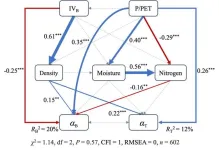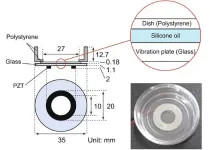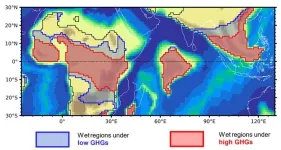(Press-News.org) BALTIMORE, Dec. 5, 2024: Obesity affects a staggering 40 percent of adults and 20 percent of children in the United States. While some new popular therapies are helping to tackle the epidemic of obesity, there is still so much that researchers do not understand about the brain-body connection that regulates appetite. Now, researchers have discovered a previously unknown population of neurons in the hypothalamus that regulate food intake and could be a promising new target for obesity drugs.
In a study published in the Dec. 5 issue of Nature, a team of researchers from the Laboratory of Medical Genetics at Rockefeller University in New York, the Institute for Genome Science (IGS) at the University of Maryland School of Medicine (UMSOM) in Baltimore, as well as New York and Stanford Universities discovered a new population of neurons that is responsive to the hormone leptin. Leptin responsive neurons are important in obesity since leptin is sent to the brain from the body’s fat stores to suppress hunger.
“We’ve long known that the hypothalamus—located deep in the brain—plays a role in hunger, hormone levels, stress responses, and body temperature,” said Brian Herb, PhD, a scientist at IGS and a Research Associate of Pharmacology, Physiology, and Drug Development at UMSOM. His research published in 2023 in Science Advances was the first time that scientists used single-cell technology to map the cells in the developing hypothalamus in humans, from precursor stem cells to mature neurons.
“Since our earlier research showed that unique regulatory programs in genes give rise to specialized neuronal populations—it makes sense that this new research discovered a previously unknown set of neurons that regulate energy and food intake,” Dr. Herb added
Through several experiments with mice, the researchers found that this previously unknown neuronal population that express both receptors for leptin and the BNC2 gene not only helps suppress hunger, but also responds to food-related sensory cues, such as food palatability and nutritional status. For example, the researchers used CRISPR-Cas 9 to knock out the leptin receptor (LEPR) in these BNC2 neurons. Those mice ate more and gained more weight than control mice. In addition, researchers added fluorescence to the BNC2 neurons and noticed when they fed mice after fasting, the BCN2 neurons activated, whereas previously known neuronal populations in the hypothalamus did not react.
“These findings add a critical new component to our understanding of how neurons impact appetite and obesity,” Dr. Herb said. “This could be a future target for obesity treatment, such as by activating these neurons to reduce weight or suppress hunger.”
About the Institute for Genome Sciences
The Institute for Genome Sciences' (IGS) has been part of the University of Maryland School of Medicine (UMSOM) since 2007. IGS scientists work in diverse areas, applying genomics and systems biology approaches to better understand health issues in premature infants, women, and transgender people; to improve vaccine development; to study evolutionary biology; and to understand cancer, parasitic, fungal, and infectious diseases, as well as identifying the underpinnings of aging, brain development, addiction, and mental health. IGS also remains at the forefront of high-throughput genomic technologies and bioinformatics analyses through its core facility, Maryland Genomics which provides researchers around the world with cutting-edge, collaborative, and cost-effective sequencing and analysis.
About the University of Maryland School of Medicine
Now in its third century, the University of Maryland School of Medicine was chartered in 1807 as the first public medical school in the United States. It continues today as one of the fastest growing, top-tier biomedical research enterprises in the world -- with 46 academic departments, centers, institutes, and programs, and a faculty of more than 3,000 physicians, scientists, and allied health professionals, including members of the National Academy of Medicine and the National Academy of Sciences, and a distinguished two-time winner of the Albert E. Lasker Award in Medical Research. With an operating budget of more than $1.2 billion, the School of Medicine works closely in partnership with the University of Maryland Medical Center and Medical System to provide research-intensive, academic, and clinically based care for nearly 2 million patients each year. The School of Medicine has more than $500 million in extramural funding, with most of its academic departments highly ranked among all medical schools in the nation in research funding. As one of the seven professional schools that make up the University of Maryland, Baltimore campus, the School of Medicine has a total population of nearly 9,000 faculty and staff, including 2,500 students, trainees, residents, and fellows. The School of Medicine, which ranks as the 8th highest among public medical schools in research productivity (according to the Association of American Medical Colleges profile) is an innovator in translational medicine, with 606 active patents and 52 start-up companies. In the latest U.S. News & World Report ranking of the Best Medical Schools, published in 2023, the UM School of Medicine is ranked #10 among the 92 public medical schools in the U.S., and in the top 16 percent (#32) of all 192 public and private U.S. medical schools. The School of Medicine works locally, nationally, and globally, with research and treatment facilities in 36 countries around the world. Visit medschool.umaryland.edu
END
Researchers discover new neurons that suppress food intake
A previously unknown population of neurons in the hypothalamus could lead to new obesity treatments
2024-12-05
ELSE PRESS RELEASES FROM THIS DATE:
Deforestation reduces malaria bed nets’ effectiveness
2024-12-05
When a forest is lost to development, some effects are obvious. Stumps and mud puddles across the landscape, a plowed field or houses a year after that. But deforestation isn’t just a loss of trees; it’s a loss of the countless benefits that forests provide—one of which is control of disease.
Now, a startling new global study shows that a widespread malaria-fighting strategy—bed nets—becomes less effective as deforestation rises. The research underscores how important a healthy environment can be for human health.
Insecticide-treated ...
Researchers develop polarization photodetector mimicking desert ant
2024-12-05
Polarization photodetectors (pol-PDs) have widespread applications in geological remote sensing, machine vision, and biological medicine. However, commercial pol-PDs usually require bulky and complicated optical components and are difficult to miniaturize and integrate.
Chinese researchers have recently made important progress in this area by developing an on-chip integrated polarization photodetector.
This study, published in Science Advances on Dec. 4, was conducted by Prof. Li Mingzhu’s group from the Technical ...
Superconducting qubit baths give clean simulation of quantum transport
2024-12-05
Researchers from Singapore and China have used a superconducting quantum processor to study the phenomenon of quantum transport in unprecedented detail.
A better understanding of quantum transport, which can refer to the flow of particles, magnetisation, energy or information through a quantum channel, could propel advances in technologies such as nanoelectronics and thermal management.
“We’re quite excited because this is, practically, a new paradigm of doing quantum transport experiments,” says Centre for Quantum Technologies (CQT) Fellow Dario Poletti, whose co-corresponding authors for the new work published in Nature ...
Astronomers witness the in situ spheroid formation in distant submillimetre-bright galaxies
2024-12-05
An international team of researchers including The University of Tokyo Kavli Institute for the Physics and Mathematics of the Universe (Kavli IPMU, WPI) has found evidence showing that old elliptical galaxies in the universe can form from intense star formation within early galaxy cores. This discovery will deepen our understanding of how galaxies evolved from the early Universe, reports a new study in Nature.
Galaxies in today’s Universe are diverse in morphologies and can be roughly divided into two categories: younger, disk-like spiral galaxies, ...
Effects of bamboo invasion on forest structures and diameter–height allometries
2024-12-05
Bamboo invasion has been widely observed across Asia (e.g., China, Japan, and India), North America, South America (e.g., Brazil and Peru) and Africa. Moso bamboo (Phyllostachys edulis), a large-running bamboo species native to subtropical China, is known for its invasive nature and ability to encroach upon adjacent communities, particularly derived forests. While some plot-based studies exist, our understanding of how forest structural dynamics and diameter–height allometric relationships respond to bamboo invasion has remained limited.
In a study published in the KeAi journal Forest Ecosystems, researchers from China ...
Ultrasonication as a tool for directing cell growth and orientation
2024-12-05
Developing reliable methods to replace dead or damaged tissue is one of the primary goals of regenerative medicine. With steady advances in tissue engineering and biomedicine, we are almost at a point where growing cell sheets in the lab and transplanting them onto damaged or diseased organs is becoming a reality rather than fiction. Notably, myoblast cell sheets have already been used to successfully treat severe heart failure, demonstrating the potential of this technology.
However, there are still a few unsolved challenges ...
Lessons from Earth's hottest epoch in the last 65 million years: How global warming could shrink the tropics' rain belt
2024-12-05
Earth's tropical rain belt, responsible for monsoons that sustain billions of people and vibrant ecosystems, has long been a reliable feature of the planet's climate. But new research reveals this vital system wasn't always so dependable. A study published in Geophysical Research Letters shows that during the early Eocene—the hottest period in the last 65 million years—the rain belt's seasonal shifts weakened dramatically. These ancient changes could offer critical warnings about the impact of modern global warming.
A Greenhouse Climate 50 Million Years ...
Independent rice paddy methane model validated for global applications: Study highlights emission mitigation potential
2024-12-05
Rice paddies, responsible for approximately 10% of global anthropogenic methane (CH₄) emissions, are increasingly recognized as a key contributor to global warming. Reducing emissions from rice cultivation is essential to achieving international climate goals, especially in light of commitments to carbon neutrality and peak emissions targets.
A team led by Prof. LI Tingting from the Institute of Atmospheric Physics at the Chinese Academy of Sciences has validated an independently developed methane emission model, CH4MOD, at the global scale. This research highlights the advantages of process-based models over the commonly ...
Infertility linked to onset of systemic autoimmune rheumatic disease after childbirth
2024-12-05
Women who experience infertility but do not use fertility treatments have a higher risk of developing a group of conditions called systemic autoimmune rheumatic diseases (SARD) in the nine years after a naturally conceived birth compared to women without fertility problems.
The new research, published today (Thursday) in Human Reproduction [1], one of the world’s leading reproductive medicine journals, found that this was true even after accounting for higher rates of pre-eclampsia (high blood pressure during pregnancy), preterm birth ...
Researchers use data from citizen scientists to uncover the mysteries of a blue low-latitude aurora
2024-12-05
Colorful auroras appeared around Japan's Honshu and Hokkaido islands on May 11, 2024, sparked by an intense magnetic storm. Usually, auroras observed at low latitudes appear red due to the emission of oxygen atoms. But on this day, a salmon pink aurora was observed throughout the night, while an unusually tall, blue-dominant aurora appeared shortly before midnight.
Smartphone videos and amateur photos captured the event, enabling scientists to combine public data with their own research and study the phenomenon.
In a ...
LAST 30 PRESS RELEASES:
House sparrows in northern Norway can help us save other endangered animals
Crohn's & Colitis Foundation survey reveals more than 1/3 of young adults with IBD face step therapy insurance barriers
Tethered UAV autonomous knotting on environmental structures for transport
Decentralized social media platforms unlock authentic consumer feedback
American Pediatric Society announces Vanderbilt University School of Medicine as host institution for APS Howland Visiting Professor Program
Scientists discover first method to safely back up quantum information
A role for orange pigments in birds and human redheads
Pathways to net-zero greenhouse gas emissions for Southeast Asia
A JBNU–KIMS collaborative study on a cost-effective alloy matches superalloys for power plants and energy infrastructure
New study overturns long-held model of how plants coordinate immune responses.
New AI model predicts disease risk while you sleep
Scientists discover molecular ‘reshuffle’ and crack an 80-year-old conundrum
How stressors during pregnancy impact the developing fetal brain
Electrons lag behind the nucleus
From fungi to brain cells: one scientist's winding path reveals how epigenomics shapes neural destiny
Schizophrenia and osteoporosis share 195 genetic loci, highlighting unexpected biological bridges between brain and bone
Schizophrenia-linked genetic variant renders key brain receptor completely unresponsive to both natural and therapeutic compounds
Innovative review reveals overlooked complexity in cellular energy sensor's dual roles in Alzheimer's disease
Autism research reframed: Why heterogeneity is the data, not the noise
Brazil's genetic treasure trove: supercentenarians reveal secrets of extreme human longevity
The (metabolic) cost of life
CFRI special issue call for papers: New Frontiers in Sustainable Finance
HKU Engineering scholar demonstrates the smallest all-printed infrared photodetectors to date
Precision empowerment for brain "eavesdropping": CAS team develops triple-electrode integrated functional electrode for simultaneous monitoring of neural signals and chemical transmitters during sleep
Single-capillary endothelial dysfunction resolved by optoacoustic mesoscopy
HKU three research projects named among ‘Top 10 Innovation & Technology News in Hong Kong 2025’ showcasing excellence in research and technology transfer
NLRSeek: A reannotation-based pipeline for mining missing NLR genes in sequenced genomes
A strand and whole genome duplication–aware collinear gene identification tool
Light storage in light cages: A revolutionary approach to on-chip quantum memories
Point spread function decoupling in computational fluorescence microscopy
[Press-News.org] Researchers discover new neurons that suppress food intakeA previously unknown population of neurons in the hypothalamus could lead to new obesity treatments







